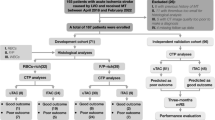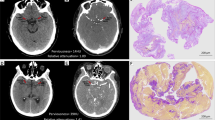Abstract
Objectives
To develop a clot-based radiomics model using CT imaging radiomic features and machine learning to identify cardioembolic (CE) stroke before mechanical thrombectomy (MTB) in patients with acute ischemic stroke (AIS).
Materials and methods
This retrospective four-center study consecutively included 403 patients with AIS who sequentially underwent CT and MTB between April 2016 and July 2021. These were grouped into training, testing, and external validation cohorts. Thrombus-extracted radiomic features and basic information were gathered to construct a machine learning model to predict CE stroke. The radiological characteristics and basic information were used to build a routine radiological model. A combined radiomics and radiological features model was also developed. The performances of all models were evaluated and compared in the validation cohort. A histological analysis helped further assess the proposed model in all patients.
Results
The radiomics model yielded an area under the curve (AUC) of 0.838 (95% confidence interval [CI], 0.771–0.891) for predicting CE stroke in the validation cohort, significantly higher than the radiological model (AUC, 0.713; 95% CI, 0.636–0.781; p = 0.007) but similar to the combined model (AUC, 0.855; 95% CI, 0.791–0.906; p = 0.14). The thrombus radiomic features achieved stronger correlations with red blood cells (|rmax|, 0.74 vs. 0.32) and fibrin and platelet (|rmax|, 0.68 vs. 0.18) than radiological characteristics.
Conclusion
The proposed CT-based radiomics model could reliably predict CE stroke in AIS, performing better than the routine radiological method.
Key Points
• Admission CT imaging could offer valuable information to identify the acute ischemic stroke source by radiomics analysis.
• The proposed CT imaging–based radiomics model yielded a higher area under the curve (0.838) than the routine radiological method (0.713; p = 0.007).
• Several radiomic features showed significantly stronger correlations with two main thrombus constituents (red blood cells, |r max |, 0.74; fibrin and platelet, |r max |, 0.68) than routine radiological characteristics.





Similar content being viewed by others
Abbreviations
- AIS:
-
Acute ischemic stroke
- AUC:
-
Area under the curve
- CE:
-
Cardioembolic
- CI:
-
Confidence interval
- CTA:
-
Computed tomography angiography
- DSA:
-
Digital subtraction angiography
- FP:
-
Fibrin and platelet
- MTB:
-
Mechanical thrombectomy
- NCCT:
-
Non-contrast computed tomography
- RBCs:
-
Red blood cells
- WBCs:
-
White blood cells
References
Campbell B, Khatri P (2020) Stroke. Lancet 396:129–142. https://doi.org/10.1016/S0140-6736(20)31179-X
Peultier AC, Pandya A, Sharma R, Severens JL, Redekop WK (2020) Cost-effectiveness of mechanical thrombectomy more than 6 hours after symptom onset among patients with acute ischemic stroke. JAMA Netw Open 3:e2012476. https://doi.org/10.1001/jamanetworkopen.2020.12476
Jovin TG, Chamorro A, Cobo E et al (2015) Thrombectomy within 8 hours after symptom onset in ischemic stroke. N Engl J Med 372:2296–2306. https://doi.org/10.1056/NEJMoa1503780
Saver JL, Goyal M, Bonafe A et al (2015) Stent-retriever thrombectomy after intravenous t-PA vs. t-PA alone in stroke. N Engl J Med 372:2285–2295. https://doi.org/10.1056/NEJMoa1415061
Campbell B, Mitchell PJ, Churilov L et al (2020) Effect of intravenous tenecteplase dose on cerebral reperfusion before thrombectomy in patients with large vessel occlusion ischemic stroke: the EXTEND-IA TNK part 2 randomized clinical trial. JAMA 323:1257–1265. https://doi.org/10.1001/jama.2020.1511
Arboix A, Alio J (2010) Cardioembolic stroke: clinical features, specific cardiac disorders and prognosis. Curr Cardiol Rev 6:150–161. https://doi.org/10.2174/157340310791658730
Hashimoto T, Hayakawa M, Funatsu N et al (2016) Histopathologic analysis of retrieved thrombi associated with successful reperfusion after acute stroke thrombectomy. Stroke 47:3035–3037. https://doi.org/10.1161/STROKEAHA.116.015228
Flottmann F, Broocks G, Faizy TD et al (2021) Factors associated with failure of reperfusion in endovascular therapy for acute ischemic stroke: a multicenter analysis. Clin Neuroradiol 31:197–205. https://doi.org/10.1007/s00062-020-00880-8
Schmitz ML, Simonsen CZ, Svendsen ML et al (2017) Ischemic stroke subtype is associated with outcome in thrombolyzed patients. Acta Neurol Scand 135:176–182. https://doi.org/10.1111/ane.12589
He G, Deng J, Lu H et al (2022) Thrombus enhancement sign on CT angiography is associated with the first pass effect of stent retrievers. J Neurointerv Surg. https://doi.org/10.1136/neurintsurg-2021-018447
Mordasini P, Brekenfeld C, Fischer U et al (2012) Passing the thrombus in endovascular treatment of acute ischemic stroke: do we penetrate the thrombus? Neuroradiol J 25:243–250. https://doi.org/10.1177/197140091202500216
Goebel J, Gaida BJ, Wanke I et al (2020) Is histologic thrombus composition in acute stroke linked to stroke etiology or to interventional parameters? AJNR Am J Neuroradiol 41:650–657. https://doi.org/10.3174/ajnr.A6467
Boodt N, Compagne K, Dutra BG et al (2020) Stroke etiology and thrombus computed tomography characteristics in patients with acute ischemic stroke: a MR CLEAN Registry substudy. Stroke 51:1727–1735. https://doi.org/10.1161/STROKEAHA.119.027749
Berndt M, Friedrich B, Maegerlein C et al (2018) Thrombus permeability in admission computed tomographic imaging indicates stroke pathogenesis based on thrombus histology. Stroke 49:2674–2682. https://doi.org/10.1161/STROKEAHA.118.021873
Zhou Y, Xu C, Zhang R et al (2019) Longer length of delayed-contrast filling of clot on 4-dimensional computed tomographic angiography predicts cardiogenic embolism. Stroke 50:2568–2570. https://doi.org/10.1161/STROKEAHA.118.024411
Boeckh-Behrens T, Kleine JF, Zimmer C et al (2016) Thrombus histology suggests cardioembolic cause in cryptogenic stroke. Stroke 47:1864–1871. https://doi.org/10.1161/STROKEAHA.116.013105
Fereidoonnezhad B, Dwivedi A, Johnson S, McCarthy R, McGarry P (2021) Blood clot fracture properties are dependent on red blood cell and fibrin content. Acta Biomater 127:213–228. https://doi.org/10.1016/j.actbio.2021.03.052
Wei L, Zhu Y, Deng J et al (2021) Visualization of thrombus enhancement on thin-slab maximum intensity projection of CT angiography: an imaging sign for predicting stroke source and thrombus compositions. Radiology 298:374–381. https://doi.org/10.1148/radiol.2020201548
Ganeshan B, Miles KA (2013) Quantifying tumour heterogeneity with CT. Cancer Imaging 13:140–149. https://doi.org/10.1102/1470-7330.2013.0015
Alvarez-Jimenez C, Sandino AA, Prasanna P, Gupta A, Viswanath SE, Romero E (2020) Identifying cross-scale associations between radiomic and pathomic signatures of non-small cell lung cancer subtypes: preliminary results. Cancers (Basel) 12. https://doi.org/10.3390/cancers12123663
Li Y, Liu X, Xu K et al (2018) MRI features can predict EGFR expression in lower grade gliomas: a voxel-based radiomic analysis. Eur Radiol 28:356–362. https://doi.org/10.1007/s00330-017-4964-z
Zhang QW, Gao YJ, Zhang RY et al (2020) Personalized CT-based radiomics nomogram preoperative predicting Ki-67 expression in gastrointestinal stromal tumors: a multicenter development and validation cohort. Clin Transl Med 9:12. https://doi.org/10.1186/s40169-020-0263-4
Hanning U, Sporns PB, Psychogios MN et al (2021) Imaging-based prediction of histological clot composition from admission CT imaging. J Neurointerv Surg. https://doi.org/10.1136/neurintsurg-2020-016774
Hofmeister J, Bernava G, Rosi A et al (2020) Clot-based radiomics predict a mechanical thrombectomy strategy for successful recanalization in acute ischemic stroke. Stroke 51:2488–2494. https://doi.org/10.1161/STROKEAHA.120.030334
Qiu W, Kuang H, Nair J et al (2019) Radiomics-based intracranial thrombus features on CT and CTA predict recanalization with intravenous alteplase in patients with acute ischemic stroke. AJNR Am J Neuroradiol 40:39–44. https://doi.org/10.3174/ajnr.A5918
Rebello LC, Bouslama M, Haussen DC et al (2017) Stroke etiology and collaterals: atheroembolic strokes have greater collateral recruitment than cardioembolic strokes. Eur J Neurol 24:762–767. https://doi.org/10.1111/ene.13287
Shafiq-Ul-Hassan M, Latifi K, Zhang G, Ullah G, Gillies R, Moros E (2018) Voxel size and gray level normalization of CT radiomic features in lung cancer. Sci Rep 8:10545. https://doi.org/10.1038/s41598-018-28895-9
Kontos D, Winham SJ, Oustimov A et al (2019) Radiomic phenotypes of mammographic parenchymal complexity: toward augmenting breast density in breast cancer risk assessment. Radiology 290:41–49. https://doi.org/10.1148/radiol.2018180179
Niesten JM, van der Schaaf IC, van Dam L et al (2014) Histopathologic composition of cerebral thrombi of acute stroke patients is correlated with stroke subtype and thrombus attenuation. PLoS One 9:e88882. https://doi.org/10.1371/journal.pone.0088882
Moftakhar P, English JD, Cooke DL et al (2013) Density of thrombus on admission CT predicts revascularization efficacy in large vessel occlusion acute ischemic stroke. Stroke 44:243–245. https://doi.org/10.1161/STROKEAHA.112.674127
Brinjikji W, Nogueira RG, Kvamme P et al (2021) Association between clot composition and stroke origin in mechanical thrombectomy patients: analysis of the Stroke Thromboembolism Registry of Imaging and Pathology. J Neurointerv Surg 13:594–598. https://doi.org/10.1136/neurintsurg-2020-017167
Jolugbo P, Ariens R (2021) Thrombus composition and efficacy of thrombolysis and thrombectomy in acute ischemic stroke. Stroke 52:1131–1142. https://doi.org/10.1161/STROKEAHA.120.032810
Liu L, Ding J, Leng X et al (2018) Guidelines for evaluation and management of cerebral collateral circulation in ischaemic stroke 2017. Stroke Vasc Neurol 3:117–130. https://doi.org/10.1136/svn-2017-000135
Funding
This work was supported by the National Natural Science Foundation of China (No. 81871329), the New Developing and Frontier Technologies of Shanghai Shen Kang Hospital Development Center (No. SHDC12018117), the Shanghai Municipal Education Commission-Gaofeng Clinical Medicine Grant Support (No. 2016427), the Shanghai Pujiang Program (No. 21PJ1411700), and the Fundamental Research Funds for the Shanghai Sixth People’s Hospital (No. x-2362).
Author information
Authors and Affiliations
Corresponding author
Ethics declarations
Guarantor
The scientific guarantor of this publication is Yuehua Li.
Conflict of interest
The authors of this manuscript declare no relationships with any companies whose products or services may be related to the subject matter of the article.
Statistics and biometry
No complex statistical methods were necessary for this paper.
Informed consent
Informed consent was obtained from all subjects (patients) in this study.
Ethical approval
Institutional Review Board approval was obtained.
Methodology
• Retrospective
• Cross sectional study
• Multicenter study
Additional information
Publisher’s note
Springer Nature remains neutral with regard to jurisdictional claims in published maps and institutional affiliations.
Supplementary Information
ESM 1
(DOCX 6395 kb)
Rights and permissions
Springer Nature or its licensor holds exclusive rights to this article under a publishing agreement with the author(s) or other rightsholder(s); author self-archiving of the accepted manuscript version of this article is solely governed by the terms of such publishing agreement and applicable law.
About this article
Cite this article
Jiang, J., Wei, J., Zhu, Y. et al. Clot-based radiomics model for cardioembolic stroke prediction with CT imaging before recanalization: a multicenter study. Eur Radiol 33, 970–980 (2023). https://doi.org/10.1007/s00330-022-09116-4
Received:
Revised:
Accepted:
Published:
Issue Date:
DOI: https://doi.org/10.1007/s00330-022-09116-4




